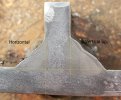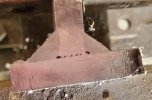Pony
Senior Member
Puts down a nice weld.
What gas mix are you running with it-
What gas mix are you running with it-

My last machine Millermatic 252 was crank voltage very high, turn up the feed speed a LOT. Imediately I burned up my hand, then I burned up the gun. Bought a massive Bernard gun & heat shields for my hand. Heat shields melted.Done some more experimentation with Dual Shield. I found horizontal fillet welds with 1.2mm (0.45) wire, you need heaps of amps 250+ to get it to penetrate into the root as the deposition rate is to great if you go too slow you end up having the arc on the puddle rather then the leading edge.
Vertical up's are like cheating though. Just hold it straight and zip it up and it is counter intuitive in that you want fast wire feed for vertical up, not slow.
Here is a cut and etch when I finally got things sorted out.
View attachment 312049
Curious why your welds have a pinhole at deepest part of the root? I ran .045" dual-shield and didn't find it that hot using a 300 amp Bernard gun. If you want hot burn some 3/32" Innershield NS3M E70T-4 at 400 amps+. You need the heat shield on the gun. Even the smaller guns for self shielded flux-core come standard with a heat shield. I think I've seen optional heat shields for standard guns though. The biggest Lincoln Innershield gun is rated at 600 amps for burning 1/8" wire! That's got to be pretty insane.Done some more experimentation with Dual Shield. I found horizontal fillet welds with 1.2mm (0.45) wire, you need heaps of amps 250+ to get it to penetrate into the root as the deposition rate is to great if you go too slow you end up having the arc on the puddle rather then the leading edge.
Vertical up's are like cheating though. Just hold it straight and zip it up and it is counter intuitive in that you want fast wire feed for vertical up, not slow.
Here is a cut and etch when I finally got things sorted out.
View attachment 312049
I wander if it isn't a small slag inclusion considering it's past the edge of the plateCurious why your welds have a pinhole at deepest part of the root? I ran .045" dual-shield and didn't find it that hot using a 300 amp Bernard gun. If you want hot burn some 3/32" Innershield NS3M E70T-4 at 400 amps+. You need the heat shield on the gun. Even the smaller guns for self shielded flux-core come standard with a heat shield. I think I've seen optional heat shields for standard guns though. The biggest Lincoln Innershield gun is rated at 600 amps for burning 1/8" wire! That's got to be pretty insane.

That is the major issue with dual shield at lower power levels.
I had endless trouble with root penetration, and further research revealed it is a common problem with horizontal fillet welds.
The fix is to get the arc on the leading edge by going faster and do not put the arc on the puddle.
Arc force blowing on the liquid puddle is absorbed much shooting a gun into water.I have an old edition of the Lincoln welders bible, there was a loose insert about a technique developed during the early stages of WW2, that showed just what you did with etching. run fast enough to use the arc force to dig into cold steel.
